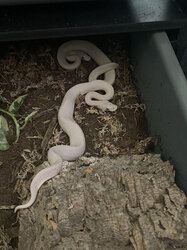Hi y’all. I’m Wes.
I’ve been wanting to write a post on ball python cohabitation, because it seems to me that the “ball pythons are solitary” line is partly a conventional wisdom that has been perpetuated through the zoological and hobby communities with little in the way of documented research and evidence.
My expectation is that many of you will consider this post reckless. However, I ask that you approach this discussion with an open mind…and specifically consider the substance and experience underlying your own views on the subject. If you have experiences that challenge my observations, post 'em! I’m here to learn, and I hope you are too. Unsubstantiated “this is wrong” comments aren’t very helpful…I strongly favor science and data.
I also want to start with a few caveats:
-
I’ve only tried cohabitation with baby and juvenile females in large and resource-rich environments.
-
I keep all of my pythons in either vivarium tanks or vivarium racks, with great temp/humidity regulation and lots of natural hides both in foliage and cork burrows. I take great care and cost to make my pythons feel secure. (does anyone else do this with racks? it works super well and provides a much richer environment…upfront cost is higher, but maintenance is much lower)
-
I have plenty of space to separate them, and have only kept them together for social experimentation.
-
In my loose experiments, every stage of interaction - from initial supervised meeting outside of habitat to sharing a vivarium - needed observational validation before increased complexity - adding a snake, letting them interact unobserved, sharing the environment, etc.
-
I never feed them together. Python feeding response is a strong behavioral override, and I’m pretty confident just from bringing feeders into the room that they would strike and coil on the same prey. I’ve seen videos of pythons competing for prey, and I don’t want to risk that.
Ok, now that those things have been said. I’m becoming increasingly confident that ball pythons are NOT strictly solitary. I started to realize this possibility merely by reading many threads on the subject…where lots of people strongly suggested otherwise without evidence, but dozens of observational anecdotes tended to be along the lines of “meh, mine seem to do fine” rather than “yeah, mine wouldn’t eat and tried to kill each other”. In one case, a family kept a large open tank in a vivarium room and their two pythons regularly returned to the tank to sleep together despite resources spread across the room. That really got me thinking, and I slowly scaled into experiments that left me with a very different view than most: just as we tend to underestimate their intelligence and arboreal nature, we drastically underestimate their capacity for socialization.
My current understanding is that ball pythons share burrows in the wild with some regularity (I’ll go back and find some citations, but I read a comprehensive census somewhere showing both this and a surprisingly high arboreal count). In addition, they are often kept together at scale in the African pet trade and in human settlements in Benin without strong stress expressions (hissing, nipping) from the videos I’ve watched.
In my own experiments, I’ve found they will typically choose to share proximity despite sufficient and distributed resources. This, along dozens of more subtle observations, makes me think that what is interpreted as ‘resource competition’ is often a form of willful interaction…and that pythons overwhelmingly socialize through touch.
For instance, I have three female juveniles (220g, 650g x2) in a single 55gal vivarium for study. It has multiple heat sources and 4 cork burrows spread across the temp gradient (two well-covered burrows on each side that measure identically for temp and humidity). Despite sufficient resources and space, these girls overwhelmingly choose to share proximity the majority of the time. When I pull one out, the others get very curious and poke heads out to watch. When I return a snake, they typically cozily meander to their shared space. I regularly watch them accommodate each other - by leaving burrows temporarily to make space for another, relaxing coil to provide a secure spot for the smallest, etc. Two of them in particular are virtually inseparable…when I bring feeders into the room, they’ll poke their heads out together in a stack, showing substantial comfort with each other while waiting to ambush prey.
The same is true for two baby sisters I keep in a 50qt vivarium rack…even when they want to be in different places, they stretch out so they continue touching at nearly all times (sometimes this looks absolutely absurd, I’ll try to take pics). And they watch sooo intently while you handle the other.
Virtually all of my observations are along these lines. I see no objective signs of increased stress in these animals. Objective is operative word - they never miss a meal and are extremely docile and relaxed during handling (my three juveniles hardly even tense up when removed from a burrow). They shed great. They NEVER nip or hiss at each other in discomfort. Any initial jerky reaction to being explored by another dissipates within like…an hour of introduction (!). Their behavior does not read to me as strictly ambivalent - very often it seems both aware and interactive.
So. I’m not here to strongly claim that I’ve found some deeper truth. I especially suspect things are testier with males or gravid females. But I think it’s worth considering the possibility that in many cases, given a rich and secure environment, pythons can share space successfully. Moreover…I think it’s a very real possibility that they can thrive with social contact, such that they feel more secure than in a solitary environment. Every single snake that I’ve tested seems to prefer being together with another.
Thoughts?




